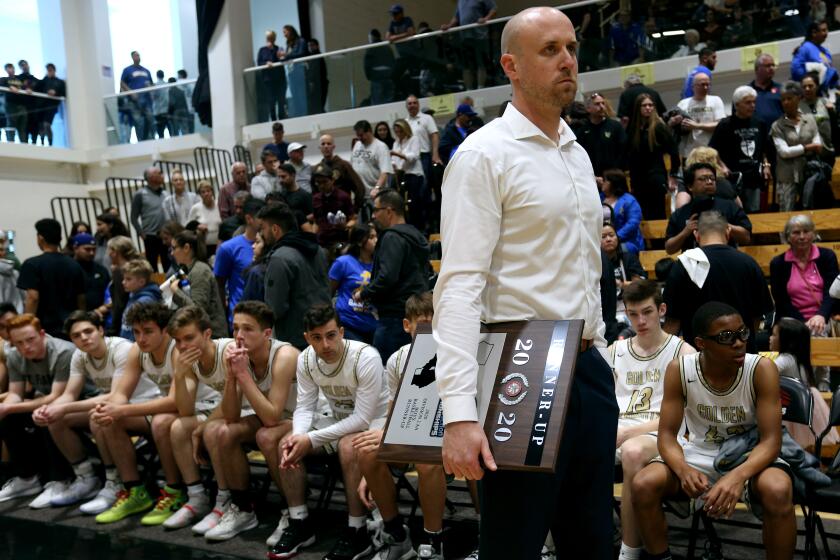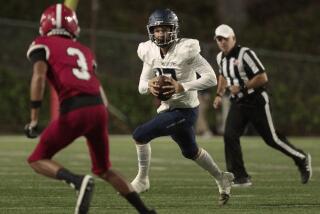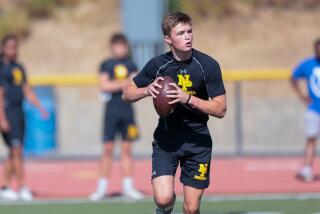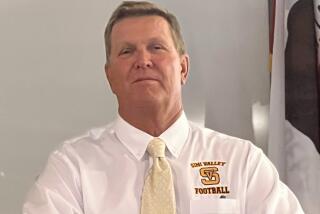Column: It’s really happening: Friday night football games in March
- Share via
It’s perfectly clear what coaches and teenagers are prepared to do to have a high school sports season.
It was 31 degrees on a practice field filled with snow at Rim of the World High in Lake Arrowhead last week. Players are required to have 14 days of mandatory practice to participate in a football game, so a little snow and ice were hardly going to deter a group of teenagers moving forward after spending 11 months prohibited from playing any sports because of the coronavirus pandemic.
They threw snow balls. They slid on ice. They shivered.
“There was a wave of emotions, ‘Yeah, we’re going to do it.’ Then they realize they have to lay in snow,” coach Joe Jurado said.
Whatever it takes to play — putting a stick up their nose once a week for a COVID-19 PCR test, showing up with their own water bottle to avoid contamination, practicing in snow — high school athletes in California are ready to do it.
Get our high school sports newsletter
Prep Rally is devoted to the SoCal high school sports experience, bringing you scores, stories and a behind-the-scenes look at what makes prep sports so popular.
You may occasionally receive promotional content from the Los Angeles Times.
Cross-country, water polo, outdoor volleyball and soccer matches have been held, but the real sign of progress will begin when Friday night football in March takes place. It’s happening this weekend.
Fans won’t be allowed at most venues. You’ll have to be a family member of a player or a volunteer to attend a game. Schools have probably had record number of people volunteering to be on the chain crew, be the school photographer, run the scoreboard clock, hold the head coach’s clipboard.
The World Health Organization announced the coronavirus outbreak had become a pandemic on March 11, 2020. Since then, the virus has seemingly touched all aspects of life in Southern California and beyond. The Times looks back on a full year of life in a pandemic.
The score of games will be kept. Winning and losing will matter to those involved. But truth be told, the five-game or six-game seasons each team plays will mean so much more than what the final record indicates.
“These kids have been through hell,” Lake Balboa Birmingham coach Jim Rose put it bluntly. “I’ve been a social worker, psychologist and coach.”
This season will be about creating positive memories, sharing poignant moments with mom and dad, impressing college recruiters and, most importantly, taking a small step toward a return to normalcy.
Fans who grade programs based solely on winning need to step back and understand this season is different.
“I’m going to play my best players, but I also want to take the opportunity for other kids to be involved for the sacrifices kids made for 11 months,” Santa Ana Mater Dei coach Bruce Rollinson said.
If one lesson was learned from having no youth sports competitions since March 2020, it’s that every practice and every game must be cherished because they can stop with little notice. Already this month three football teams — Arcadia, Crescenta Valley, Santa Fe — had to shut down their programs for 10 days to quarantine because of positive tests and will miss playing in season openers.
High school sports have resumed after the COVID-19 shutdown. Here is how it touched aspects of athletes’ lives, from school to training to recruiting.
There are so many unsung heroes who’ve contributed to a return to sports, and one group is athletic directors. They’ve been working nonstop creating schedules, coordinating safety protocols and figuring out how to use facilities six days a week in a four-month period with as many as 12 sports going at once.
“I put in a bunk bed in my office and brought my guitar to relax,” Encino Crespi athletic director Brian Bilek said. “I said goodbye to my wife, ‘See you in June.’”
The appreciation is felt by parents, like the mother of a water polo player who wrote to me, “So very grateful that the kids are able to play. It has been the one thing that has helped my kids keep their sanity through this year. Being able to watch them play in person last week was amazing. We felt so normal for that short time. It was a blessing.”
More to Read
Get our high school sports newsletter
Prep Rally is devoted to the SoCal high school sports experience, bringing you scores, stories and a behind-the-scenes look at what makes prep sports so popular.
You may occasionally receive promotional content from the Los Angeles Times.









